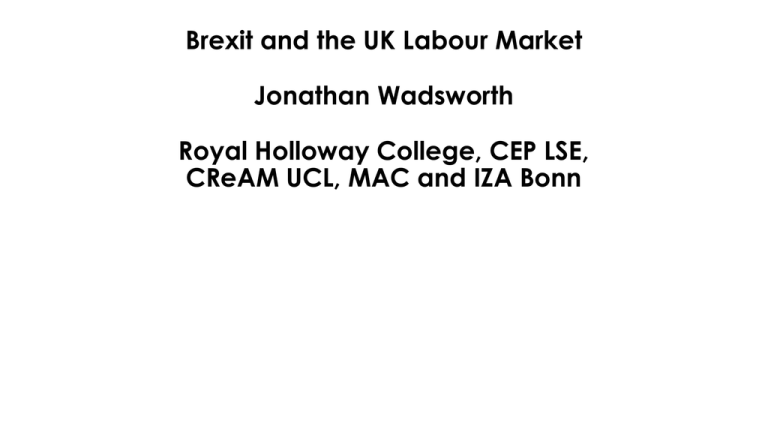Brexit and the UK Labour Market Jonathan Wadsworth
advertisement

Brexit and the UK Labour Market Jonathan Wadsworth Royal Holloway College, CEP LSE, CReAM UCL, MAC and IZA Bonn Forecasting the likely consequences of a UK exit from the EU is fraught with difficulties There are so many policy options, institutional factors and their interactions that determine labour market performance that are as yet unknown and may play out in different ways, (Eg visa quotas, residency requirements, corporate behaviour, trade agreements, reaction in other countries) Focus instead on what did happen Knowing where we are may be a pointer to what might happen if policy went into reverse How economists think about the decision to migrate Move if (perceived) benefits > (perceived) costs Compare Benefits Costs Wages Employment Prospects Housing Costs Entry Costs – Visas, Quotas, accreditation Assimilation (language, institutions) Welfare in home country with those elsewhere (not just UK) The result of those decisions manifests in movement of peoples in and out of each country 400 300 0 Net Immigration (Inflows – Outflows) 300,000 200 2015 Yearly Inflows 600,00 Yearly Outflows 300,000 100 yearly flows (thousands) All Annual Flows 500 600 Net Immigration to the UK Rising for more than 20 years 1991 Source: LTIM ONS 1995 1999 2003 year Net Migration Emigration 2007 2011 Immigration 2015 Concern over growing numbers of EU arrivals? 0 50 100 150 200 250 Net Immigration to UK 1991 1995 1999 2003 year EU 2007 Non-EU 2011 2015 Concern over growing numbers of EU arrivals? Non-EU Flows 400 300 200 0 100 0 100 200 yearly flows (thousands) 300 400 EU Flows 1991 1995 1999 2003 year Net Migration Emigration 2007 2011 Immigration 2015 1991 1995 1999 2003 year Net Migration Emigration 2007 2011 Immigration 2015 Yearly Inflows 260,00 Yearly Outflows 90,000 2015 Yearly Inflows 290,00 Yearly Outflows 90,000 Net Immigration (Inflows – Outflows) 170,000 Net Immigration (Inflows – Outflows) 200,000 2015 More EU 15 than A8 with some recent A2 0 20 40 60 80 100 Net EU Immigration to UK 2004 2006 2008 2010 year rest of EU A2 2012 A8 2015 More EU 15 than A8 with some recent A2 A8 Flows 150 100 0 50 0 50 100 yearly flows (thousands) 150 EU 15 Flows 1991 1995 1999 2003 year Net Migration Emigration 2007 2011 Immigration 2015 1991 1995 1999 2003 year Net Migration Emigration 2007 2011 Immigration 2015 Yearly Inflows 130,00 Yearly Outflows 50,000 2015 Yearly Inflows 70,00 Yearly Outflows 30,000 Net Immigration (Inflows – Outflows) 170,000 Net Immigration (Inflows – Outflows) 40,000 2015 EU-nationals more educated than UK nationals (and non—EU nationals more so – visa system) 0 .1 .2 .3 .4 .5 Year Left Education by Nationality 2015 UK EU <=16 21+ Non-EU 17-20 EU-nationals younger than UK nationals (and non—EU nationals more so – visa system) 0 .2 .4 .6 Age Distribution by Nationality 2015 UK EU 16-24 50-64 Non-EU 25-49 Tyne & Wear Rest of Northern region South Yorkshire West Yorkshire Rest of Yorks & Humberside East Midlands East Anglia Inner London Outer London Rest of South East South West West Midlands (met county) Rest of West Midlands Greater Manchester Merseyside Rest of North West Wales Strathclyde Rest of Scotland Northern Ireland Tyne & Wear Rest of Northern region South Yorkshire West Yorkshire Rest of Yorks & Humberside East Midlands East Anglia Inner London Outer London Rest of South East South West West Midlands (met county) Rest of West Midlands Greater Manchester Merseyside Rest of North West Wales Strathclyde Rest of Scotland Northern Ireland 0 5 10 15 % Share of EU Nationals in Area 0 20 5 10 15 % Share of Non-EU Nationals in Area 20 Geographic dispersion of EU migrants similar to that of other migrants - more concentrated on London & South-East Tyne & Wear Rest of Northern region South Yorkshire West Yorkshire Rest of Yorks & Humberside East Midlands East Anglia Inner London Outer London Rest of South East South West West Midlands (met county) Rest of West Midlands Greater Manchester Merseyside Rest of North West Wales Strathclyde Rest of Scotland Northern Ireland In contrast to geographic distribution of UK nationals 0 5 10 15 % Share of UK Nationals in Area 20 EU-nationals more likely to be in work than UK nationals - and as likely to be unemployed (and non-EU nationals less likely – but this is partly age and partly gender driven) 0 .2 .4 .6 .8 Labour Force Status by Nationality 2015 UK EU Employed Inactive Non-EU Unemployed EU-Nationals living in the UK (2015 q3) 300,000 born in UK Students (160,000) 3.3 million EU nationals in UK 5% UK population 3 million born outside UK Children <16 (300,000) Workforce (2.5 million) Employed 2 million (6% of all employed) Unemployed 100,000 (5% of all unemployed) Inactive 490,000 (3% of inactive) Source: LFS author calculations EU Employed by Nationality: Total 3.1 million EU Unemployed by Nationality: Total =100,000 Polish, 31.1% Other, 41.5% Polish, 16.9% Other, 60.2% Irish, 7.6% Italian, 6.0% Romanian, 6.8% Source: LFS, ILO definition Portugal, 7.0% Italian, 11.1% Romanian, 11.8% Net result is that EU nationals seem to be net contributors - Pay more in taxes than receive in benefits - Unlike UK nationals Source: Dustmann & Frattini (2014) In-Work benefit claims? Employed Tax Credit Claimants 2015 : 2.8 million (LFS estimates) 70,000, 3% 190,000, 7% 150,000, 5% EU_nationals>4 years EU-Nationals<4 years Other Immigrants UK nationals 2,400,000, 85% Notes: Advisory only. LFS known to underestimate numbers in receipt of benefits Eligible for Residency? EU-Nationals living in the UK by Years in UK (2015 q3) 770,000 in UK < 4 years 60,00 students, 150,000<age16 450,000 employed 30,000 unemployed 3.3 million EU nationals in UK 5% UK population 2.5 million in UK>=4 years Source: LFS author calculations Approx ¾ EU-nationals may be eligible for residency What are EU- nationals doing? Occupation EU workforce % Share in Occupation Non-EU immigrant workforce % Share in Occupation Managers 110,000 3.0 320,000 9.9 Professionals 310,000 5.0 800,000 12.9 Associate Professionals 210,000 5.0 340,000 8.1 Administrative 150,000 4.4 270,000 8.0 Skilled Trades 240,000 7.1 230,000 6.9 Caring & Leisure 170,000 5.9 340,000 11.8 90,000 3.6 200,000 8.5 Processing 240,000 12.2 220,000 11.1 Elementary 460,000 13.1 380,000 10.9 Total 2.0 million 6.3 3.1 million 10.0 Sales EU-Nationals and Non-EU by Occupation Elementary processing 31%, Elementary Storage, 19% EU-Nationals by Industry Industry EU workforce % Share in Industry Non-EU immigrant workforce % Share in Industry Agriculture 20,000 5.4 10,000 3.3 Energy 20,000 4.3 30,000 5.2 Manufacturing 310,000 10.4 210,000 10.4 Construction 160,000 7.1 120,000 5.5 Retail, Hospitality 440,000 7.7 640,000 11.1 Transport 210,000 7.4 400,000 14.1 Finance 340,000 6.4 560,000 10.6 Public Admin. 380,000 4.1 960,000 10.4 Other Services 90,000 4.8 160,000 8.6 Total 2.0 million 6.3 3.1 million Source: LFS 2015, numbers rounded 10.0 Food Manufacturing 32%, Domestic Help, 17% Any evidence that immigration affects wage and employment prospects of UK- born? Many people worry about rising immigration because they think this means competition for jobs and puts downward pressure on wages. This tends to neglect the fact that rising immigration raises demand (for food, clothes etc) and so it is not a given that employment or wages of UK nationals will fall. That said, estimating the causal effects of rising EU immigration is not an easy task. Any estimate is also likely to be an average that conceals losses and gains for some. The graphs below are therefore just suggestive of the likely link between EU immigration and the unemployment and wage rates of UK-born workers. 8 UK-Born Unemployment Rate 2 4 6 Graph compares change in unemployment rates for UK-born 2004-2012 with Change in immigrant share in each “county” over same period -2 0 Red line suggests little association between unemployment rates and pace of immigration 0 2 4 6 8 10 % Change in County Immigrant Share 2004-2012 local area Values Fitted Value Graph compares change in unemployment rates for UK-born 2004-2012 with Change in EU-Born immigrant share in each “county” over same period -2 0 2 4 6 8 UK-Born Unemployment Rate 0 2 4 6 % Change in County EU-Born Immigrant Share 2004-2012 local area Values Fitted Value 8 If anything red line suggests statistically significant negative association ie uk-born unemployment rates rose least in areas with lots of EU-immigration Now do same for the recovery period 2 4 UK-Born Unemployment Rate -4 -2 0 Graph now compares change in unemployment rates for UK-born 2012-2014 with Change in immigrant share in each “county” over same period -6 Red line suggests little association in upturn -4 -2 0 2 4 6 % Change in County Immigrant Share 2012-2014 local area Values Fitted Value UK-Born Unemployment Rate (a negative slope would now mean unemp. rates fell more in areas with larger growth in immigration share) 0 2 4 Graph compares change in unemployment rates for UKborn 2012-2014 with Change in EU-Born immigrant share in each “county” over same period -6 -4 -2 Red line again suggests little association in upturn -2 0 2 % Change in County EU-Born Immigrant Share 2012-2014 local area Values Fitted Value 4 Now do same for real wages 7 UK-Born Real Wages: 2004-2012 -5 -2 1 4 Graph compares % change in real wage rates for UKborn 2004-2012 with change in immigrant share in each “county” over same period -14 -11 -8 Red line suggests statistically insignificant - though negative - association between wage rates and pace of immigration 0 2 4 6 8 10 % Change in local area Immigrant Share 2004-2012 local area Values Fitted Value UK-Born Real Wages: 2004-2012 1 4 7 Graph compares change in unemployment rates for UKborn 2004-2012 with Change in EU-Born immigrant share in each “county” over same period -14 -11 -8 -5 -2 Again statistically insignificant negative association with EU rates of immigration 0 2 4 6 % Change in local area EU-Born Immigrant Share 2004-2012 local area Values Fitted Value 8 UK-Born Real Wages: 2012-2014 6 9 Now do same for real wages in the upturn -6 -3 0 3 Graph compares % change in real wage rates for UKborn 2012-2014 with change in immigrant share in each “county” over same period -12 -9 Red line now suggests statistically insignificant positive association between wage rates and pace of immigration -4 -2 0 2 4 6 % Change in local area Immigrant Share 2012-2014 local area Values ie wage rates for UK-born grew most in areas where immigration grew most Graph compares change in unemployment rates for UKborn 2004-2012 with Change in EU-Born immigrant share in each “county” over same period Fitted Value 0 3 6 9 UK-Born Real Wages: 2012-2014 -12 -9 -6 -3 Again little statistically insignificant – negative - association with EU rates of immigration -2 0 2 % Change in local area EU-Born Immigrant Share 2012-2014 local area Values Fitted Value 4 So what are we to conclude? Little evidence of large adverse labour market effects on the UK-born population of rising EU immigration. Nor is there much evidence of large gains. Leaving the EU might attenuate population growth (and hence GDP), but would not make much difference to the welfare bill (net of tax revenues) but the effects on the labour market are just not that easy to divine without more details on the type of institutions and regulations that would emerge in the wake of a UK exit. Appendix Rules on UK Citizenship Children born in the UK to citizens of the European Economic Area may be British citizens depending on when they were born. Children born: From 1 January 1983 to 2 October 2000 will be British citizens if either parent was living in the UK at the time; From 2 October 2000 to 29 April 2006 will only be British citizens if at least one parent had obtained indefinite leave to remain or the unconditional right to permanent residence in the UK prior to the birth; On or after 30 April 2006 will be British citizens if at least one parent lived in the UK continuously for five years pursuant to their rights under European law prior to the birth The LFS 2015 suggests that there are 500,000 individuals born in the UK who are EU rather than British citizens EU-Born Individuals living in the UK (2015) 400,000 UK Nationals 3.1 million EU born in UK (2015) Students (120,000) 5% UK population 36% of all immigrants to UK 2.7 million non-UK nationals Children <16 (300,000) Workforce (2.2 million) Employed 1.7 million (6% of all employed) Unemployed 80,000 (4% of all unemployed) Inactive 430,000 (2% of inactive) Source: LFS Non-EU-Nationals living in the UK (2015 q3) Students (330,000) 5.7 million Non-EU nationals born abroad in UK 9% UK population 5.7 million born outside UK Children <16 (410,000) Workforce (4.9 million) Employed 3.1 million (10% of all employed) Unemployed 220,000 (13% of all unemployed) Inactive 1.6 million (10% of inactive) Geographic dispersion of EU migrants similar to that of other migrants Northern Ireland Rest of Northern region Rest of Scotland Wales Rest of North West Rest of Yorks & Humberside Strathclyde Merseyside Rest of West Midlands Tyne & Wear South West South Yorkshire East Anglia East Midlands Rest of South East West Yorkshire Greater Manchester West Midlands (met county) Outer London Inner London 0 .1 .2 Share of Area Population Non-EU .3 EU





